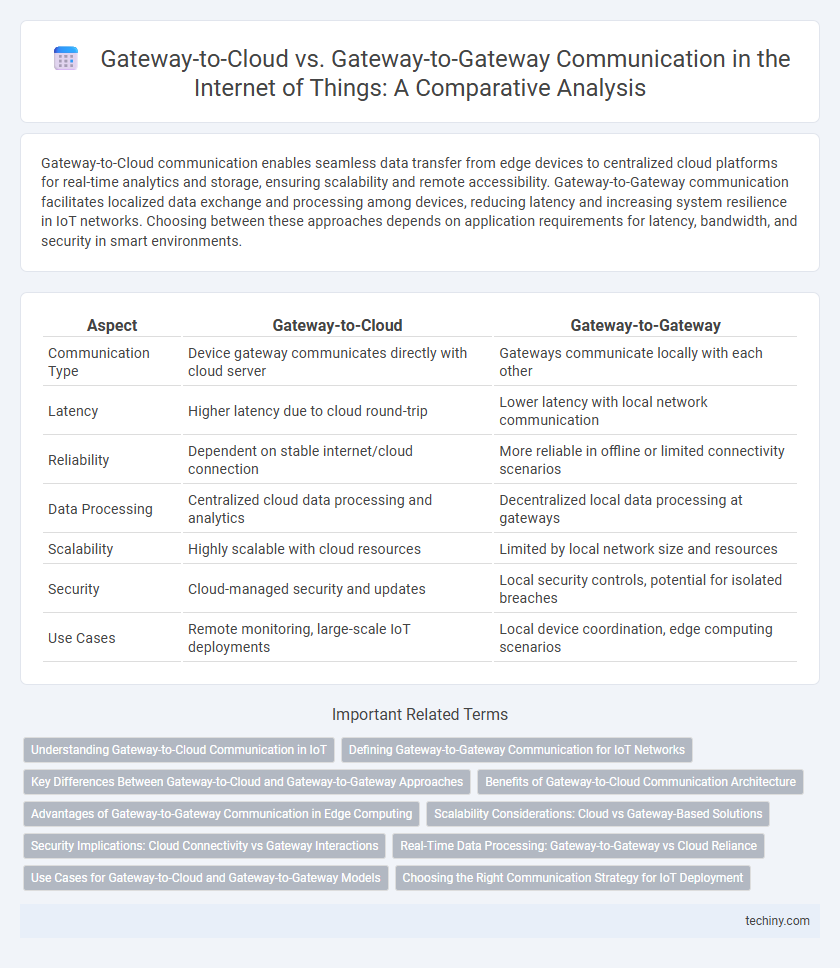Gateway-to-Cloud communication enables seamless data transfer from edge devices to centralized cloud platforms for real-time analytics and storage, ensuring scalability and remote accessibility. Gateway-to-Gateway communication facilitates localized data exchange and processing among devices, reducing latency and increasing system resilience in IoT networks. Choosing between these approaches depends on application requirements for latency, bandwidth, and security in smart environments.
Table of Comparison
| Aspect | Gateway-to-Cloud | Gateway-to-Gateway |
|---|---|---|
| Communication Type | Device gateway communicates directly with cloud server | Gateways communicate locally with each other |
| Latency | Higher latency due to cloud round-trip | Lower latency with local network communication |
| Reliability | Dependent on stable internet/cloud connection | More reliable in offline or limited connectivity scenarios |
| Data Processing | Centralized cloud data processing and analytics | Decentralized local data processing at gateways |
| Scalability | Highly scalable with cloud resources | Limited by local network size and resources |
| Security | Cloud-managed security and updates | Local security controls, potential for isolated breaches |
| Use Cases | Remote monitoring, large-scale IoT deployments | Local device coordination, edge computing scenarios |
Understanding Gateway-to-Cloud Communication in IoT
Gateway-to-cloud communication in IoT involves transferring data from edge gateways directly to cloud platforms for processing, storage, and analysis, enabling centralized management and real-time insights. This communication model supports scalability and seamless integration with advanced cloud services such as machine learning and big data analytics. Optimized protocols like MQTT and CoAP ensure efficient, reliable data transmission between IoT gateways and cloud infrastructures.
Defining Gateway-to-Gateway Communication for IoT Networks
Gateway-to-Gateway communication in IoT networks enables direct data exchange between multiple gateways, facilitating localized processing and reducing latency compared to Gateway-to-Cloud models. This decentralized architecture enhances network reliability and supports real-time decision-making by allowing gateways to share sensor data and control signals without relying on cloud connectivity. Implementing Gateway-to-Gateway communication optimizes bandwidth usage and improves security by limiting data exposure to external cloud environments.
Key Differences Between Gateway-to-Cloud and Gateway-to-Gateway Approaches
Gateway-to-Cloud communication relies on transmitting data from edge gateways directly to centralized cloud servers for processing and storage, ensuring scalable analytics and remote management. In contrast, Gateway-to-Gateway communication enables direct data exchange between local gateways, facilitating low-latency interactions and decentralized processing at the edge. Key differences include latency, data privacy, network dependency, and architecture complexity, with Gateway-to-Cloud favoring centralized control and Gateway-to-Gateway emphasizing local autonomy in IoT deployments.
Benefits of Gateway-to-Cloud Communication Architecture
Gateway-to-cloud communication architecture enhances scalability by enabling seamless data aggregation from multiple gateways into centralized cloud platforms for advanced analytics and storage. This model improves real-time monitoring and decision-making through continuous data synchronization and remote management capabilities. Secure data transmission protocols and automated updates in gateway-to-cloud setups reduce operational risks and maintenance costs compared to gateway-to-gateway communication.
Advantages of Gateway-to-Gateway Communication in Edge Computing
Gateway-to-Gateway communication in edge computing reduces latency by enabling direct data exchange between gateways, bypassing the cloud for faster decision-making. This method enhances network reliability and security through localized data processing, minimizing exposure to external threats and cloud outages. It also optimizes bandwidth usage by limiting the need for constant cloud connectivity, which is crucial for real-time IoT applications and edge analytics.
Scalability Considerations: Cloud vs Gateway-Based Solutions
Gateway-to-cloud communication offers superior scalability by leveraging cloud computing resources to manage vast IoT networks with centralized data processing and storage. Gateway-to-gateway communication limits scalability due to localized processing and bandwidth constraints, making it suitable for smaller, constrained environments. Cloud-based solutions enable dynamic resource allocation and seamless integration with advanced analytics, enhancing scalability beyond the capabilities of gateway-only architectures.
Security Implications: Cloud Connectivity vs Gateway Interactions
Gateway-to-cloud communication centralizes data processing and security management within robust cloud platforms, enabling advanced encryption protocols, continuous threat monitoring, and scalable access controls to protect IoT networks. In contrast, gateway-to-gateway communication relies on localized device interactions, which may expose vulnerabilities due to limited security resources, inconsistent update mechanisms, and lack of centralized oversight. Ensuring secure cloud connectivity demands comprehensive authentication frameworks and end-to-end encryption, whereas securing gateway interactions requires resilient device-level security measures and intrusion detection to safeguard distributed IoT architectures.
Real-Time Data Processing: Gateway-to-Gateway vs Cloud Reliance
Gateway-to-Gateway communication enables real-time data processing by allowing IoT devices to exchange information directly with minimal latency, improving responsiveness and reducing bandwidth dependency. Cloud reliance in Gateway-to-Cloud communication introduces delays due to data transmission and processing over the internet, which can impact time-sensitive applications. Edge computing capabilities within Gateway-to-Gateway models enhance immediate decision-making, while cloud platforms offer scalable analytics and long-term data storage, highlighting the trade-off between speed and capacity.
Use Cases for Gateway-to-Cloud and Gateway-to-Gateway Models
Gateway-to-Cloud communication is ideal for large-scale IoT deployments requiring centralized data processing, remote device management, and integration with cloud analytics platforms such as AWS IoT or Azure IoT Hub. Gateway-to-Gateway communication excels in local network environments where low latency, real-time data exchange, and decentralized decision-making are critical, such as in industrial automation or smart grid systems. Use cases for Gateway-to-Cloud include smart city monitoring and predictive maintenance, while Gateway-to-Gateway models are suited for edge computing scenarios and peer-to-peer sensor networks.
Choosing the Right Communication Strategy for IoT Deployment
Selecting the optimal communication strategy for IoT deployment hinges on understanding Gateway-to-Cloud and Gateway-to-Gateway communication. Gateway-to-Cloud communication enables centralized data processing and seamless integration with cloud platforms like AWS IoT and Microsoft Azure IoT, offering scalability and robust analytics capabilities. In contrast, Gateway-to-Gateway communication supports localized data exchange, reduces latency, and enhances system resilience by enabling direct interactions between devices in edge environments, essential for time-sensitive or bandwidth-constrained applications.
Gateway-to-Cloud vs Gateway-to-Gateway Communication Infographic

 techiny.com
techiny.com